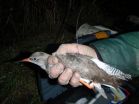(Press-News.org) A jet of X-rays from a supermassive black hole 12.4 billion light years from Earth has been detected by NASA's Chandra X-ray Observatory. This is the most distant X-ray jet ever observed and gives astronomers a glimpse into the explosive activity associated with the growth of supermassive black holes in the early universe.
The jet was produced by a quasar named GB 1428+4217, or GB 1428 for short. Giant black holes at the centers of galaxies can pull in matter at a rapid rate producing the quasar phenomenon. The energy released as particles fall toward the black hole generates intense radiation and powerful beams of high-energy particles that blast away from the black hole at nearly the speed of light. These particle beams can interact with magnetic fields or ambient photons to produce jets of radiation.
"We're excited about this result not just because it's a record holder, but because very few X-ray jets are known in the early universe," said Teddy Cheung of the National Academy of Sciences, resident at the Naval Research Laboratory in Washington DC, and lead author of the paper describing these results.
As the electrons in the jet fly away from the quasar, they move through a sea of background photons left behind after the Big Bang. When a fast-moving electron collides with one of these so-called cosmic microwave background photons, it can boost the photon's energy into the X-ray band.
"Since the brightness of the jet in X-rays depends, among other things, on how fast the electrons are moving away from the black hole, discoveries like the jet in GB 1428 tell us something about the environment around supermassive black holes and their host galaxies not that long after the Big Bang," said co-author Lukasz Stawarz from the Japan Aerospace Exploration Agency in Kanagawa, Japan.
Because the quasar is seen when the universe is at an age of about 1.3 billion years, less than 10% of its current value, the cosmic background radiation is a thousand times more intense than it is now. This makes the jet much brighter, and compensates in part for the dimming due to distance.
"We're lucky that the universe gives us this natural amplifier and lets us detect this object with relatively short exposures," said co-author Aneta Siemiginowska, of the Harvard-Smithsonian Center for Astrophysics in Cambridge, MA, "Otherwise we might miss important physical processes happening at very large distances from Earth and as far away as GB 1428."
While there is another possible source of X-rays for the jet -- radiation from electrons spiraling around magnetic field lines in the jet -- the authors favor the idea that the cosmic background radiation is being boosted because the jet is so bright.
Prior to the discovery of the jet in GB 1428, the most distant X-ray jet known was 12.2 billion light years away, and another is located at about 12 billion light years, both discovered by authors of the GB 1428 paper. A very similar shaped jet in GB 1428 was also detected in radio waves with the NSF's Very Large Array (VLA).
The particle beams that produce these three extremely distant X-ray jets appear to be moving slightly more slowly than jets from galaxies that are not as far away. This may be because the jets were less energetic when launched from the black hole or because they are slowed down more by their environment.
The researchers think the length of the jet in GB 1428 is at least 230,000 light years, or about twice the diameter of the entire Milky Way galaxy. This jet is only seen on one side of the quasar in the Chandra and VLA data. When combined with previously obtained evidence, this suggests the jet is pointed almost directly toward us. This configuration would boost the X-ray and radio signals for the observed jet and diminish those for a jet presumably pointed in the opposite direction.
Observations were also taken of GB 1428 with a set of radio telescopes at different locations around the Earth that allows details to be resolved on exceptionally small scales. They revealed the presence of a much smaller jet, about 1,900 light years long, which points in a similar direction to the X-ray jet.
INFORMATION:
This result appeared in the September 1st, 2012 issue of The Astrophysical Journal Letters. Other co-authors of the paper are Doug Gobeille from University of South Florida in Tampa, FL; John Wardle from Brandeis University in Waltham, MA; and Dan Harris and Dan Schwartz from the Harvard-Smithsonian Center for Astrophysics.
NASA's Marshall Space Flight Center in Huntsville, Ala., manages the Chandra Program for NASA's Science Mission Directorate in Washington. The Smithsonian Astrophysical Observatory controls Chandra's science and flight operations from Cambridge, Mass.
Record-setting X-ray jet discovered
2012-11-28
ELSE PRESS RELEASES FROM THIS DATE:
Banking Industry Veteran Michael Sanchez Addresses Conference at IMPACT 2012 Venture Summit
2012-11-28
Savana Inc CEO Michael Sanchez, was one of several financial services industry executives invited to speak at the recently held IMPACT 2012 Venture Summit Mid-Atlantic hosted by the Greater Philadelphia Alliance for Capital and Technologies (PACT). Sanchez joined a panel to share his insight on trends in Fin-Tech and how the financial services industry is changing to support new business models through the use of software-based innovation.
Over a thousand attendees participated in the two day summit which featured speakers including former AOL Chairman Steve Case, former ...
4 common antipsychotic drugs found to lack safety and effectiveness in older adults
2012-11-28
In older adults, antipsychotic drugs are commonly prescribed off-label for a number of disorders outside of their Food and Drug Administration (FDA)-approved indications – schizophrenia and bipolar disorder. The largest number of antipsychotic prescriptions in older adults is for behavioral disturbances associated with dementia, some of which carry FDA warnings on prescription information for these drugs.
In a new study – led by researchers at the University of California, San Diego School of Medicine, Stanford University and the University of Iowa, and funded by the ...
The hungry caterpillar: Beware your enemy's enemy's enemy
2012-11-28
When herbivores such as caterpillars feed, plants may "call for help" by emitting volatiles, which can indirectly help defend the plants. The volatiles recruit parasitoids that infect, consume and kill the herbivores, to the benefit of the plant. However, such induced plant odours can also be detected by other organisms. A new study published November 27 in the open access journal PLOS Biology shows how secondary parasitoids ('hyperparasitoids') can take advantage of these plant signals to identify parasitoid-infected caterpillars, and duly infect the primary parasitoid, ...
Studies examine whether therapies for heart failure are associated with improved survival
2012-11-28
CHICAGO – An analysis of two heart failure therapies finds differing outcomes regarding improvement in survival, according to two studies appearing in the November 28 issue of JAMA.
In one study, Adrian F. Hernandez, M.D., M.H.S., of the Duke Clinical Research Institute, Durham, N.C., and colleagues examined the clinical effectiveness of aldosterone antagonist therapy and associations with long-term outcomes of older patients discharged from a hospitalization for heart failure.
"Aldosterone antagonist therapy [a diuretic drug] for heart failure and reduced ejection ...
Heart failure drug less effective in real world
2012-11-28
DURHAM, N.C. – A large study addressing the effectiveness and safety of aldosterone antagonist therapy for older heart failure patients has found notable differences between the drug's results in clinical trial vs. what occurs in actual practice, according to researchers at Duke Medicine.
Those differences have been noted anecdotally by doctors, and likely contributed to the slow adoption of aldosterone antagonists in clinical practice, but they had not been confirmed in a large study examining the drugs in real-world situations.
The Duke-led research, published Nov. ...
Risk of pertussis increases as time since last dose of DTaP vaccine lengthens
2012-11-28
CHICAGO – In an examination of cases of childhood pertussis in California, researchers found that children with pertussis had lower odds of having received all 5 doses of the diphtheria, tetanus, and acellular pertussis vaccine (DTaP) vaccine series; however the odds increased as the time since last DTaP dose lengthened, which is consistent with a progressive decrease in estimated vaccine effectiveness each year after the final dose of DTaP vaccine, according to a study in the November 28 issue of JAMA.
"Pertussis remains a poorly controlled vaccine-preventable disease ...
Study examines anticoagulation treatment following aortic valve replacement
2012-11-28
CHICAGO – Although current guidelines recommend 3 months of anticoagulation treatment after bioprosthetic aortic valve replacement surgery, a study that included more than 4,000 patients found that patients who had warfarin therapy continued between 3 and 6 months after surgery had a lower rate of cardiovascular death, according to a study in the November 28 issue of JAMA.
"Biological prostheses are preferred to mechanical valves for aortic valve replacement (AVR) surgery in elderly patients older than 65 years because of shorter life expectancy and lack of a need to ...
How infidelity helps nieces and nephews
2012-11-28
SALT LAKE CITY, Nov. 27, 2012 – A University of Utah study produced new mathematical support for a theory that explains why men in some cultures often feed and care for their sisters' children: where extramarital sex is common and accepted, a man's genes are more likely to be passed on by their sister's kids than by their wife's kids.
The theory previously was believed valid only if a man was likely to be the biological father of less than one in four of his wife's children – a number that anthropologists found improbably low.
But in the new study, University of ...
Ecologists shed new light on effects of light pollution on wildlife
2012-11-28
Coasts and estuaries are among the most rapidly developing areas on Earth. Night-time satellite images of the planet show that except Antarctica, continents are ringed with halos of brightly-lit human development. But coasts are also key wildlife sites. Every year, millions of waterbirds arrive from the Arctic to overwinter on UK coasts, yet scientists remain largely in the dark about how these birds respond to the bright lights of coastal cities and industry.
To shed light on the issue, Dr Ross Dwyer and colleagues from the University of Exeter investigated how artificial ...
Sea-levels rising faster than IPCC projections
2012-11-28
Sea-levels are rising 60 per cent faster than the Intergovernmental Panel on Climate Change's (IPCC) central projections, new research suggests.
While temperature rises appear to be consistent with the projections made in the IPCC's fourth assessment report (AR4), satellite measurements show that sea-levels are actually rising at a rate of 3.2 mm a year compared to the best estimate of 2 mm a year in the report.
The researchers, from the Potsdam Institute for Climate Impact Research, Tempo Analytics and Laboratoire d'Etudes en Géophysique et Océanographie Spatiales, ...



